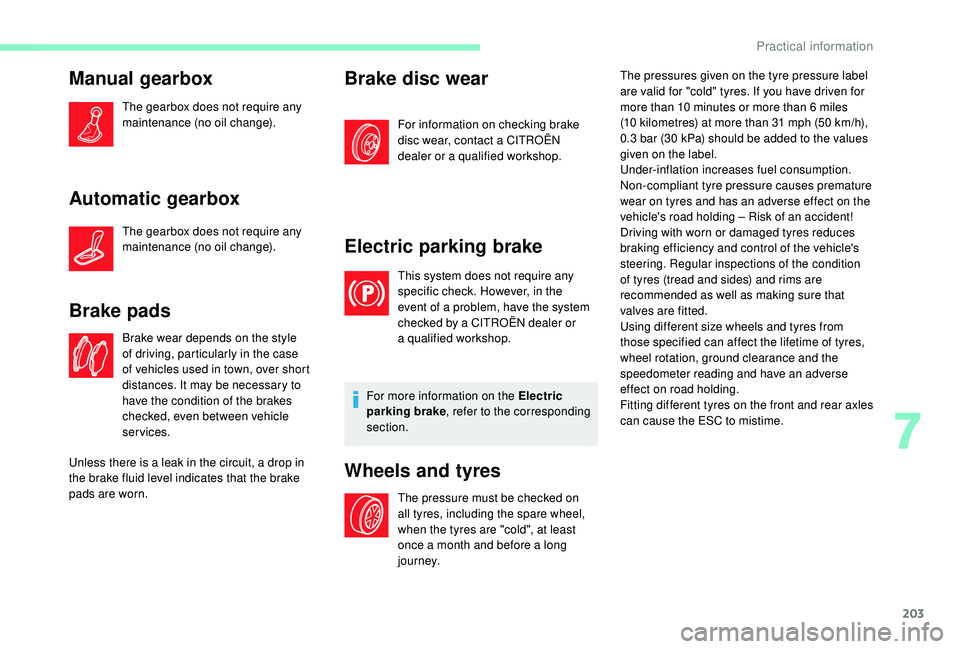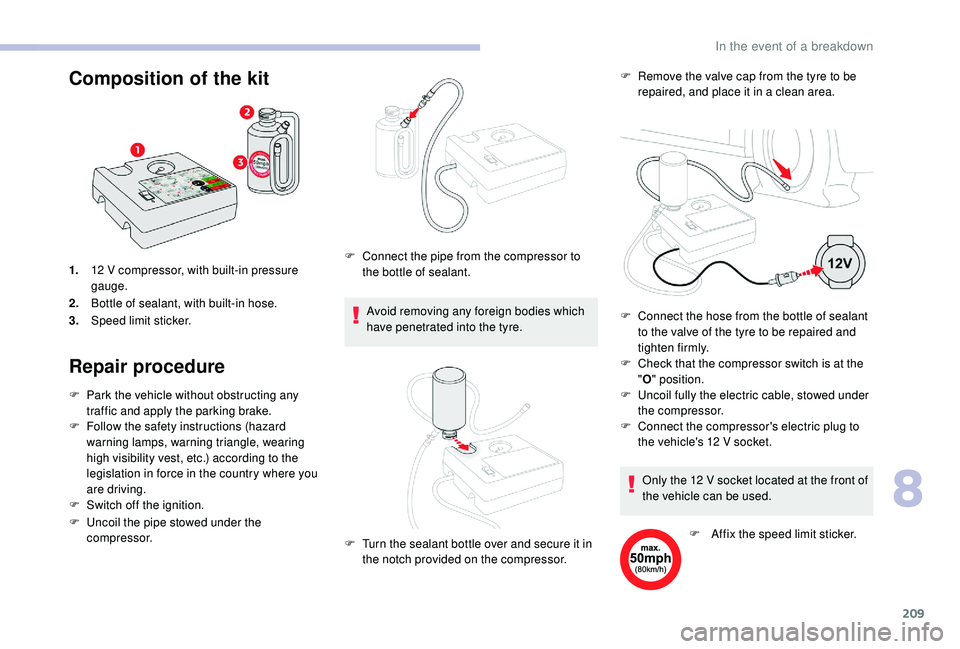tyre pressure CITROEN C4 PICASSO 2022 Owners Manual
[x] Cancel search | Manufacturer: CITROEN, Model Year: 2022, Model line: C4 PICASSO, Model: CITROEN C4 PICASSO 2022Pages: 316, PDF Size: 10.36 MB
Page 9 of 316

7
Observe the recommendations
on maintenance
Check the tyre pressures regularly, when cold,
referring to the label in the door aperture,
driver's side.
Carry out this check in particular:
-
b
efore a long journey,
-
a
t each change of season,
-
a
fter a long period out of use.
Do not forget the spare wheel and the tyres on
any trailer or caravan. Have your vehicle ser viced regularly (engine
oil, oil filter, air filter, cabin filter, etc.) and
obser ve the schedule of operations in the
manufacturer's service schedule.
With a
BlueHDi Diesel engine, if the SCR
system is faulty, your vehicle becomes
polluting. Visit a CITROËN dealer or
a qualified workshop as soon as possible to
bring your vehicle's nitrogen oxide emissions
back in line with the regulations.
When filling the tank, do not continue after the
3rd cut-off of the nozzle to avoid over flow.
At the wheel of your new vehicle, it is only
after the first 1,900
miles (3,000 kilometres)
that you will see the fuel consumption settle
down to a
consistent average.
At the end of winter, remove snow tyres and
refit your summer tyres. Limit the loads carried in the vehicle and
reduce wind resistance (roof bars, roof rack,
bicycle carrier, trailer, etc.). Preferably, use a
roof box.
Remove roof bars and roof racks after use.
.
Eco-driving
Page 24 of 316

22
(1): You must stop as soon as it is safe to do
so and switch off the ignition. (2): Contact a
CITROËN dealer or a qualified
workshop. (3)
: Go to a CITROËN dealer or a qualified
workshop.
Warning/indicator lamp
StateCause Actions/Observations
Under-inflation Fixed, accompanied
by an audible signal
and a message.
The pressure in one or more tyres is
too low.
Check the pressure of the tyres as soon as possible.
Reinitialise the detection system after adjusting the
pressure.
+ Under-inflation
Under-inflation
warning lamp flashing
then fixed and Ser vice
warning lamp fixed.The system is faulty: tyre pressures
are no longer monitored.
Under-inflation detection is no longer monitored.
As soon as possible, check the pressure of the tyres
and carry out (3).
Diesel engine
pre-heating Temporarily on.
When switching on the ignition, if the
weather conditions and the engine
temperature make it necessary. Wait until the warning lamp goes off before starting.
When the warning lamp goes off, starting is
immediate if you press and hold:
-
t
he clutch pedal with a manual gearbox.
-
t
he brake pedal with an automatic gearbox.
If the engine does not start, switch the ignition off and
then on, wait until the warning lamp goes off again,
then start the engine.
Airbags Fixed. One of the airbags or seat belt
pretensioners is faulty. Carry out (3).
Front passenger
airbag (ON) Fixed.
The front passenger airbag is
activated.
The control is in the "ON" position. In this case, do NOT install a "
rearward facing"
child seat on the front passenger seat – Risk of
serious injury!
Instruments
Page 106 of 316

104
Definitions
Anti-lock braking system (ABS)
and electronic brake force
distribution (EBFD)
These systems improve the stability and
manoeuvrability of your vehicle when braking
and contribute towards improved control in
corners, in particular on poor or slippery road
surfaces.
The ABS prevents wheel lock in the event of
emergency braking.
The EBFD system manages the braking
pressure wheel by wheel.
Emergency braking assistance
(EBA)
In an emergency, this system enables you to
reach the optimum braking pressure more
quickly and therefore reduce the stopping
distance.
It is triggered in relation to the speed at which
the brake pedal is pressed. This is felt by
a reduction in the resistance of the pedal and
an increase in the effectiveness of the braking.
Anti-slip regulation (ASR)
This system (also known as Traction Control)
optimises traction in order to limit wheel slip by
acting on the brakes of the driving wheels and
on the engine. It also improves the directional
stability of the vehicle on acceleration.
Dynamic stability control (DSC)
If there is a difference between the path
f ollowed by the vehicle and that required by
the driver, the DSC monitors each wheel and
automatically acts on the brake of one or more
wheels and on the engine to return the vehicle
to the required path, within the limits of the laws
of physics.
Intelligent traction control
( " Snow motion ")
Depending on version, your vehicle has
a
system to help driving on snow: intelligent
traction control.
This system detects situations of poor sur face
grip that could make it difficult to move off
or make progress on deep fresh snow or
compacted snow.
In these situations, the intelligent traction
control limits the amount of wheel spin to
provide the best traction and trajectory control
for your vehicle.
The use of snow tyres is strongly
recommended on sur faces offering low
levels of grip.
Anti-lock braking system
(ABS) and electronic brake
force distribution (EBFD)
When lit up continuously, this
warning lamp indicates a fault with
the ABS.
If this warning lamp comes on, in
conjunction with the STOP and ABS
warning lamps, an audible signal
and a
message, it means that the
electronic brake force distribution
(EBFD) is defective.
The vehicle retains conventional braking. Drive
carefully at moderate speed.
You must stop the vehicle as soon as it is
safe to do so.
In both cases, have the system checked by
a
CITROËN dealer or a qualified workshop as
soon as possible.
When changing wheels (tyres and rims),
ensure that these are approved for your
vehicle.
When operating under normal conditions,
the ABS may cause the brake pedal to
vibrate slightly.
Safety
Page 107 of 316

105
In emergency braking, press the brake
pedal hard and maintain this pressure.
After an impact, have these systems
checked by a CITROËN dealer or
a
qualified workshop.
Anti-slip regulation (ASR)/
Dynamic stability control
(DSC)
Operation
These systems are activated automatically
every time the vehicle is started.
They come into operation in the event of
a problem with grip or trajectory.
Deactivation of the ASR
In exceptional conditions (starting a vehicle
w hich is bogged down, stuck in snow, on soft
ground, etc.), it may be advisable to deactivate
the ASR system, so that the wheels can turn
freely and regain grip. F
I
n the Driving
menu, select the " Driving
functions " tab, then " Traction control".
Deactivation is confirmed by the display of
a
message.
The ASR system no longer acts on the
operation of the engine or the brakes in the
event of an involuntary change of trajectory.
Reactivation of the ASR
The system is reactivated automatically every
time the ignition is switched back on or from
31
mph (50 km/h).
Below 31
mph (50 km/h), you can reactivate it
manually:
F
I
n the Driving menu, select the " Driving
functions " tab, then " Traction control".
Operating fault
The illumination of this warning
lamp, accompanied by an audible
signal and a
message, indicates that
there is a
fault with these systems. ASR/DSC
These systems offer increased safety
in normal driving, but they should not
encourage the driver to take extra risks or
drive at high speed.
It is in conditions of reduced grip (rain,
snow, ice) that the risk of loss of grip
increases. It is therefore important for your
safety to keep these systems activated in
all conditions, and particularly in difficult
conditions.
The correct operation of these systems
depends on observation of the
manufacturer's recommendations, not
only about the wheels (tyres and rims),
braking and electronic components but
also the assembly and repair procedures
used by CITROËN dealers.
To benefit in full from the effectiveness
of these systems in wintry conditions,
the vehicle must be fitted with four snow
tyres, allowing the vehicle to retain neutral
behaviour on the road.
This is indicated by flashing of this
warning lamp in the instrument
panel. Reactivate the system when grip conditions
allow.
Contact a
CITROËN dealer or a qualified
workshop to have the systems checked.
5
Safety
Page 129 of 316

127
In case of towing
Driving with a trailer places greater
d emands on the towing vehicle and
requires extra care from the driver.
Side wind
F Take into account the increased sensitivity to wind.
Cooling
Towing a trailer on a slope increases the
t emperature of the coolant.
As the fan is electrically controlled, its cooling
capacity is not dependent on the engine speed.
F
T
o lower the engine speed, reduce your
speed.
The maximum towable load on an incline
depends on the gradient and the exterior
temperature.
In all cases, keep a
check on the coolant
temperature.
F
I
f this warning lamp and the
STOP warning lamp come on,
stop the vehicle and switch off
the engine as soon as possible.
New vehicle
Do not pull a trailer before having driven at least
approximately 620
miles (1,000
kilometres).
Braking
Towing a trailer increases the braking distance.
T o avoid overheating of the brakes, the use of
engine braking is recommended.
Ty r e s
F Check the tyre pressures of the towing vehicle and of the trailer, observing the
recommended pressures.
Lighting
F Check the electrical lighting and signalling on the trailer and the headlamp beam height
of your vehicle.
For more information on Headlamp
adjustment , refer to the corresponding
section.
Certain driving or manoeuvring aid
functions are automatically disabled if an
approved towing system is used.
Anti-theft protection
Electronic immobiliser
The keys contain an electronic chip which has
a secret code. When the ignition is switched
on, this code must be recognised in order for
starting to be possible.
This electronic engine immobiliser locks the
engine management system a
few moments
after the ignition is switched off, and prevents
starting of the engine by anyone who does not
have the key.
In the event of a
malfunction, you are informed
by a
message in the instrument panel screen.
If this happens, your vehicle will not start;
contact a
CITROËN dealer if required.
Starting/switching off
the engine using the
electronic key
Starting the engine
6
Driving
Page 144 of 316

142
Have it checked by a CITROËN dealer or
a qualified workshop.
If a
fault occurs in STOP mode, the engine may
stall.
All of the instrument panel warning lamps come
on.
Depending on version, an alert message may also
be displayed, asking you to place the gear lever in
position N and press the brake pedal.
It is then necessary to switch off the ignition and
start the engine again using the "START/STOP"
button.
The Stop & Start requires the use of
a 12 V battery of special specification and
technology.
All work on this type of battery must be
carried out only by a
CITROËN dealer or
a
qualified workshop.
For more information on the 12
V batter y,
refer to the corresponding section.
Opening the bonnet
Before doing anything under the bonnet,
deactivate the Stop & Start system to avoid
the risk of injury related to an automatic
change to START mode. Driving on flooded roads
Before driving in a
flooded area, it is
strongly recommended that you deactivate
the Stop & Start system.
For more information on Driving advice ,
particularly on flooded roads, refer to the
corresponding section.
Tyre under-inflation
detection
System which automatically checks the
pressures of the tyres while driving.
The system monitors the pressure of the four
tyres when the vehicle is moving.
It compares the information given by the
wheel speed sensors with reference values,
which must be reinitialised after ever y tyre
pressure adjustment or wheel change .
The system triggers an alert as soon as it
detects a
drop in the pressure of one or more
tyres. The under-inflation detection system does
not replace the need for vigilance on the
part of the driver.
This system does not avoid the need to
check the tyre pressures (including the
spare wheel) every month as well as
before a
long journey.
Driving with under-inflated tyres worsens
road-holding, lengthens braking distances,
causes premature wear of the tyres,
particularly in adverse conditions (heavy
loads, high speeds, long journeys).
Driving with under-inflated tyres
increases fuel consumption.
The inflation pressures defined for your
vehicle can be found on the tyre pressure
label.
For more information on the
Identification markings , refer to the
corresponding section.
Driving
Page 145 of 316

143
Checking tyre pressures
This check should be done when the tyres
are "cold" (vehicle stopped for 1 hour or
after a
journey of less than 6 miles (10 km)
at moderate speeds).
Other wise, add 0.3
bar (30 kPa) to the
values indicated on the label.
Under-inflation alert
This is indicated by continuous
illumination of this warning lamp,
an audible signal and, depending
on equipment, the display of
a
message.
F
R
educe speed immediately, avoid excessive
steering movements and sudden braking.
F
S
top the vehicle as soon as it is safe to do
so.
The loss of pressure detected does not
always cause visible bulging of the tyre.
Do not satisfy yourself with just a
visual
check. F
I
f it is not possible to make this check
immediately, drive carefully at reduced
speed.
or
F
I
n case of a puncture, use the temporary
puncture repair kit or the spare wheel
(depending on equipment).
The alert is kept active until the system is
reinitialised.Reinitialisation
The system must be reinitialised after any
adjustment to the pressures of one or more
tyres, and after changing one or more wheels.
Before reinitialising the system, ensure
that the pressures of the four tyres
are correct for the conditions of use
of the vehicle and conform to the
recommendations on the tyre pressure
label.
The under-inflation alert can only be relied
on if the reinitialisation of the system has
been done with the pressures in the four
tyres correctly adjusted.
The under-inflation detection system
does not give a
warning if a pressure is
incorrect at the time of reinitialisation. Snow chains
The system does not have to be
reinitialised after fitting or removing snow
chains.
Reinitialisation of the system is done on the
touch screen, with the ignition on and the
vehicle stationary.
F
I
n the Driving
menu, select the " Driving
functions " tab, then " Under-inflation
initialisation ".
F
C
onfirm the instruction by pressing "
Ye s",
an audible signal and a message confirm
the reinitialisation.
The new pressure parameters saved are
treated as reference values by the system.
Malfunction
F If you have a compressor, such as the one
in the temporary puncture repair kit, check
the pressures of the four tyres when cold. In this case, under-inflation monitoring of the
tyres is no longer provided.
Have the system checked by a
CITROËN
dealer or a
qualified workshop.
The flashing and then fixed illumination of the
under-inflation warning lamp accompanied
by illumination of the Ser vice warning lamp
indicates a
fault with the system.
A message appears, accompanied by an
audible signal.
6
Driving
Page 146 of 316

144
Memorising speeds
This function allows speeds to be saved, which
can then be offered to set the two systems: the
speed limiter (to limit the speed of the vehicle)
or the cruise control (for a vehicle cruising
speed).
You can memorise up to six speed settings
for each of the two systems. By default, some
speed settings are already memorised.
Memorisation
This function can be accessed in the Driving
menu of the touch screen.
F
Sel
ect the " Driving functions " tab then
Adjusting Speeds . F
P
ress the button corresponding to the
speed setting you want to modify.
F
E
nter the new value using the numerical
keypad and confirm.
As a safety measure, the driver must carry
out these operations when stationary.
After carrying out any work on the system,
the pressure of the four tyres must be
checked and the system reinitialised.
F
S
elect the system for which you want to
memorise new speed settings.
Speed Limit recognition
and recommendation
This system allows the speed limit detected by
the camera to be displayed in the instrument
panel.
The system also processes speed limit
information from the navigation system
mapping.
You should update your navigation
mapping regularly in order to receive
accurate speed limit information from the
system.
Specific speed limits, such as those for heavy
goods vehicles, are not displayed.
The display of the speed limit in the instrument
panel is updated as you pass a
speed limit sign
intended for cars (light vehicles).
Driving
Page 205 of 316

203
Manual gearbox
The gearbox does not require any
maintenance (no oil change).
Automatic gearbox
The gearbox does not require any
maintenance (no oil change).
Brake pads
Brake wear depends on the style
of driving, particularly in the case
of vehicles used in town, over short
distances. It may be necessary to
have the condition of the brakes
checked, even between vehicle
services.
Unless there is a
leak in the circuit, a drop in
the brake fluid level indicates that the brake
pads are worn.
Brake disc wear
For information on checking brake
disc wear, contact a CITROËN
dealer or a
qualified workshop.
Electric parking brake
This system does not require any
specific check. However, in the
event of a problem, have the system
checked by a
CITROËN dealer or
a
qualified workshop.
For more information on the Electric
parking brake , refer to the corresponding
section.
Wheels and tyres
The pressure must be checked on
all tyres, including the spare wheel,
when the tyres are "cold", at least
once a
month and before a long
j o u r n ey. The pressures given on the tyre pressure label
are valid for "cold" tyres. If you have driven for
more than 10
minutes or more than 6 miles
(10 kilometres) at more than 31 mph (50 km/h),
0.3 bar (30 kPa) should be added to the values
given on the label.
Under-inflation increases fuel consumption.
Non-compliant tyre pressure causes premature
wear on tyres and has an adverse effect on the
vehicle's road holding – Risk of an accident!
Driving with worn or damaged tyres reduces
braking efficiency and control of the vehicle's
steering. Regular inspections of the condition
of tyres (tread and sides) and rims are
recommended as well as making sure that
valves are fitted.
Using different size wheels and tyres from
those specified can affect the lifetime of tyres,
wheel rotation, ground clearance and the
speedometer reading and have an adverse
effect on road holding.
Fitting different tyres on the front and rear axles
can cause the ESC to mistime.
7
Practical information
Page 211 of 316

209
F Park the vehicle without obstructing any traffic and apply the parking brake.
F
F
ollow the safety instructions (hazard
warning lamps, warning triangle, wearing
high visibility vest, etc.) according to the
legislation in force in the country where you
are driving.
F
S
witch off the ignition.
F
U
ncoil the pipe stowed under the
compressor. Avoid removing any foreign bodies which
have penetrated into the tyre.F
R
emove the valve cap from the tyre to be
repaired, and place it in a
clean area.
F
C
heck that the compressor switch is at the
" O " position.
F U ncoil fully the electric cable, stowed under
the compressor.
Only the 12
V socket located at the front of
the vehicle can be used.
F
A
ffix the speed limit sticker.
1.
12 V compressor, with built-in pressure
gauge.
2. Bottle of sealant, with built-in hose.
3. Speed limit sticker.
Repair procedure Composition of the kit
F Connect the pipe from the compressor to
the bottle of sealant.
F
T
urn the sealant bottle over and secure it in
the notch provided on the compressor. F
C
onnect the hose from the bottle of sealant
to the valve of the tyre to be repaired and
tighten firmly.
F
C
onnect the compressor's electric plug to
the vehicle's 12
V socket.
8
In the event of a breakdown